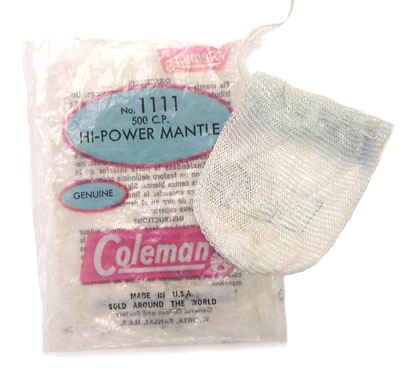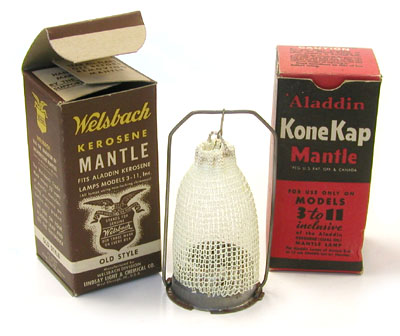Incandescent Gas Lantern Mantles

The thorium-containing incandescent mantle was invented in 1884 by Carl Auer von Welsbach, an Austrian chemist, and it is sometimes referred to as a “Welsbach mantle” or “Auerlicht.” This invention resulted in the first commercial use of the element thorium. Today, these mantles are generally used in portable lanterns for camping. Some are used in outdoor light fixtures, and some are used indoors, especially in vacation cabins.
The mantles are produced by dipping a meshed fabric (e.g., nylon web) into a solution of thorium nitrate. Other metals are added to the solution for a variety of reasons. For example, cerium is added to increase the light output, while beryllium increases the mantle’s strength. The fabric is then removed from the solution and dried. Lastly, it is coated with lacquer and fashioned into one of two types of mantles: a soft mantle or a hard mantle. The soft mantle is essentially a bag with either a drawstring or some type of fitting that attaches the mantle to the burner. The fabric of a hard mantle is supported by a metal frame that gives it a dome-like shape.
In use, fuel is burned inside the mantle—the heating of the latter causes the thorium to emit an incandescent glow. The type of fuel depends on the type of lantern/lamp, it might be liquid or gas. When the mantle is heated up for the first time (a cure), the thorium is converted to thorium oxide, the lacquer is burned off, and a variety of materials are released into the air. The material becoming airborne includes approximately 50 % of the beryllium and many of the radioactive decay products of the thorium.
Production Data

I have not seen much quantitative information about the thorium content of the mantles. Nevertheless, NUREG-1717 assumed that a typical mantle contained 250 mg (0.027 uCi) for the purpose of its dose calculations. They noted that some mantles contained up to 400 mg. Luetzelschwab and Googins measured a total of 0.065 uCi in two mantles.
In 1952, approximately 65 % of the thorium produced in the U.S. was being used in lantern mantles. It has been estimated that the annual production/sales of mantles in the U.S. was 20 million in 1974, 25 million in 1981 and 50 million in 2000. Sometime around 1990, the Coleman Company replaced the thorium in their mantles with yttrium. The yttrium mantle produces about 20% less light, but it lasts longer. According to NUREG-1717, about half of the 50 million mantles sold in the U.S. in 2000 (or thereabouts), contained thorium.
Estimates of the Radiation Exposures
A very detailed analysis of the radiation exposures due to thorium containing gas lantern mantles can be found in section 3.4 of the Nuclear Regulatory Commission publication “Systematic Radiological Assessment of Exemptions for Source and Byproduct Materials” (NUREG-1717).
The inhalation doses were based on the assumption that all of the Rn-220 in the mantle was released and that 30 % of the radium was volatilized when the mantles were ignited.
The highest exposure, 200 mrem per year, was to a hypothetical individual who lived in a residence for 4800 hours per year in which the only source of light was four gas lantern mantles.
A dose of 2 mrem was calculated for a small child who played with a used mantle and ingested part of the ash.
Avid campers were estimated to receive 0.05 to 6 mrem per year, while the estimate for one-time campers was 0.002 to 0.06 mrem.
Pertinent Regulations
10 CFR 40.13 Unimportant quantities of source material (2003)
(c) Any person is exempt from the regulation in this part and from the requirements for a license set forth in section 62 of the Act to the extent that such person receives, possesses, uses, or transfers:
(1) Any quantities of thorium contained in (i) incandescent gas mantles,
References
- Luetzelschwab, J.W. and S.W. Googins. Radioactivity Released from Burning Gas Lantern Mantles. Health Physics 46 (4): 873-881; 1984.
- Radiation Exposure of the U.S. Population from Consumer Products and Miscellaneous Sources. NCRP Report No. 95; 1987.
- Nuclear Regulatory Commission. Systematic Radiological Assessment of Exemptions for Source and Byproduct Materials. NUREG 1717. June 2001.
